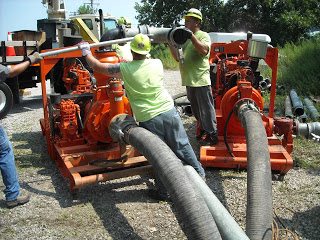ALERT: Swimming advisory posted at Edgewater Beach
Posted by Jared Shepherd
- 5279 Views
- August 15th, 2011
- in Miscellaneous
- No Comments
Today, the Northeast Ohio Regional Sewer District posted a public advisory at Edgewater Beach; the advisory was posted as a result of a combined sewer overflow (CSO) event at the beach on August 14.
LEARN MORE ABOUT COMBINED SEWERS: What is a CSO?
This overflow discharged a combination of raw sewage and stormwater into Lake Erie during yesterday evening’s heavy rain event. Visitors—particularly children, the elderly and those in ill health—are advised to avoid contact with the water and debris.
“Our region has experienced many strong storms this year, an ongoing trend that we will see more of in the future,” said Frank Greenland, Director of Watershed Programs. “CSOs, along with flooding and streambank erosion, all impact water quality throughout our region. Fortunately, the Sewer District is developing a regional solution to manage these sizeable issues and protect our region’s greatest natural resource: Lake Erie.”
Since 1972, the Sewer District has reduced the volume of combined sewer overflows from 9 billion gallons to 4.5 billion gallons. Throughout the mid-1970s, the combined sewer outfall at Edgewater Beach discharged raw sewage into Lake Erie approximately 40 to 50 times per year. However, because of the Sewer District’s improvements to aging infrastructure, the Edgewater combined sewer overflow discharges have significantly decreased. The last Edgewater discharge occurred July 19, 2011; however, prior to that event, the outfall last discharged July 13, 2010.
The Sewer District’s Project Clean Lake—a 25-year, $3 billion capital improvement plan—will enable the Sewer District to continue constructing additional tunnels throughout Greater Cleveland, further reducing raw sewage from entering local waterways. The Sewer District has recently broken ground on the Euclid Creek Tunnel which will drastically improve water quality near Euclid Beach and Villa Angela Beach. The Mill Creek Tunnel, which is near completion, will be able to contain 75 million gallons of raw sewage when fully on-line, redirecting sewage to the Southerly Wastewater Treatment Plant instead of local waterways.
Other mid-west cities, with similar combined sewer infrastructure, are addressing combined sewer overflow issues as well.


